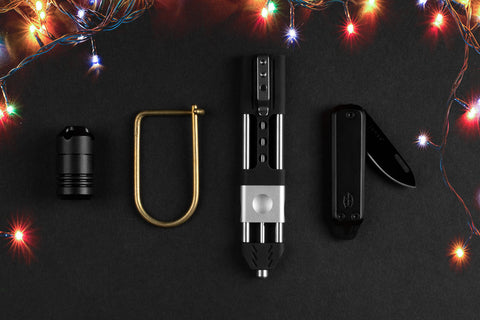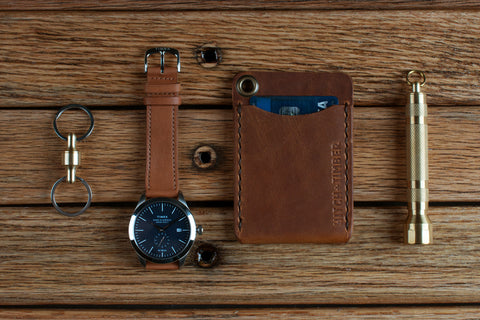The History of Multi-Tools

Multi-tools are vastly useful devices which are purposed to, in a pinch, replace a more traditional set of tools. To be clear, you should not throw out your grandfather's toolbox if you decide to pick up a multi-tool. They are not intended to be a complete replacement for your average toolbox, but rather a handy substitute when a larger and more cumbersome set of tools is not reasonable to have. For instance, if you are going on a multi-day backpacking expedition, you might need some devices to help you along the way, but it wouldn't be wise to add an extra 50 pounds of steel to your pack. So you'd want to pack a multi-tool.
They're great in the day-to-day, as well. Smaller multi-tools can fit on your keychain for added portability and many of them feature a multitude of functions that come in handy in the case that you need a quick and easy fix - such as rulers, box cutters, pry bars, wrenches, drivers, etc. Many of you who are familiar with EDC already know this. What you may not know, however, is that the story of the multi-tool dates back to the time of the Romans. So we've done the grunt work to piece that story together. This is it.
Ancient Utility

EDC Card
At its height, the Roman Empire stretched from Portugal in the west to the Persian Gulf in the east and from the U.K. in the north to Ethiopia in the south - covering an area of about 1.7 million square miles. Traversing an expanse of land that large is a feat in and of itself, but - if you were to head out on some kind of extended vacation through what is now Europe - it would be even harder to do whilst carrying with you the kinds of utensils necessary to lend you the creature comforts of everyday life - such as knives, forks, and spoons.
Apparently, some intrepid Roman traveler thought differently and was not willing to give up their eating utensils, but was also not willing to lug around a more traditional set. A rudimentary iron and silver folding tool from around 200-300 CE was discovered somewhere in the Mediterranean region that features a spoon, fork, spatula, spike, pick, and knife - probably the property of someone relatively well-off, judging by the materials out of which it was constructed. As far as anyone can tell, this is the oldest example of a multi-tool.
Modern Mechanism

Griffin Pocket Tool
While versions of multi-tools may have popped up here and there throughout history, it wouldn't be until late into the 1800s - nearly two millennia after the creation of the Roman folding utensil set - that they would emerge from obscurity to become more than just novel contraptions. And that was thanks, in no small part, to Victorinox - the company responsible for the creation of the Swiss Army Knife - and their long-time rivals, Wenger.
The company that would become Victorinox began in 1884 as a cutler's knife workshop, started by a man named Karl Elsener in the town of Ibach in the Schwyz region of Switzerland. In a series of fortuitous events, the Swiss Army ended up giving Elsener's workshop the opportunity to become the world's most influential folding tool company. They decided - in 1886 - to begin issuing every one of their soldiers a single-blade folding knife as a part of their standard gear. Three years later, in 1889, they introduced a new rifle to their men which required the use of a screwdriver in order to disassemble it for cleaning and maintenance.
So, the Swiss Army, instead of adding another stand-alone tool to their standard set of soldier's gear, decided to contract with Elsener in the creation of a multi-faceted folding tool which would include a knife, screwdriver, can opener, and reamer (a rotary tool designed to widen or finish preexisting holes). In 1891, Karl Elsener established the Association of Swiss Master Cutlers to complete the order of what would become the first Swiss Army Knife.
In 1893, Paul Boechat & Cie - the company that would become Wenger - was established and promptly began contracting with the Swiss Army to be the second cutler's workshop to produce a version of the Swiss Army Knife. From that point, the two companies would become the chief producers of multitools for the greater part of the next century.
1897: Karl Elsener patents the original Swiss Officer's and Sports Knife. Theodore Wenger is hired as the general manager of Paul Boechat & Cie.
1900: Paul Boechat & Cie is renamed Fabrique Suisse de Courtetelle et Services and their new 18,000 square foot facility is built.
1908: To avoid conflict between the two companies, the Swiss Army issues a split contract to Elsener and Wenger that dictates that each company would supply exactly half of the army's knives. Each company is also required to build the knives to the exact same specifications.
1909: Following the death of his mother, Karl Elsener changes the name of his company to Victoria, after her.
1921: Stainless steel, internationally known as Inox, is invented. Victoria is renamed Victorinox.
1929: Theodore Wenger dies and majority share in the company goes to Kaspar Oertli. The company will remain largely unchanged for nearly 60 years.
1931: Carl Elsener II takes over control of Victorinox and introduces the first all-electric automation. Now all knives can be made of consistent quality.
In 2005, four years after the terrorist attacks of 9/11, new international airport regulations had caused a severe enough dip in the sales of Swiss Army Knives at duty-free shops that Wenger was acquired by their nearly 100-year rivals, Victorinox. Now, both companies still exist and produce a wide variety of products - including each of their original versions of the Swiss Army Knife - but they operate under the same umbrella company, Victorinox AG.
Tooling Around

Mini/Inch Tool Pen
After their initial wave of competition, Victorinox and Wenger settled in to a relatively comfortable space, as they were - for the most part - the sole manufacturers of multi-tools. And they would stay in that comfortable space, offering little in the way of real innovation, until another small company would take the reigns in 1983. That company was - and still is - called Leatherman.
After having grown up in Oregon, received a BS in Mechanical Engineering, and spent a lot of time abroad, Tim Leatherman realized that there was a gap between the things that he needed and the things that were offered by the more traditional folding tools of Victorinox or Wenger. The conclusion that he came to, more than anything else, was that he needed a folding multi-tool that was built around pliers, rather than a knife. So he made one.
Partnering up with a college friend, Steve Berliner, Leatherman Tool Group was incorporated on July 5th, 1983. That same year, they sold their first product - the Pocket Survival Tool (PST for short). And they still sell a version of that same tool today. Since then, they have continued to pioneer and innovate at the forefront of the multi-tool industry. But they also opened the doors for other companies, manufacturers, and designers to start making similarly innovative multi-tools.
Now the market is awash with a multitude of noteworthy offerings from companies such as Gerber, SOG, and even Victorinox, Wenger, and their other daughter brands. And it isn't just large-scale companies and corporations that are building high quality multi-tools. There are literal dozens of small-scale organizations and even independent artisans that are designing and constructing their own versions of multi-tools. In fact, the newest wave on the market focuses on both miniaturization, portability, and designs with as few moving parts as possible (as a means to increase tool longevity).
As is the case with many other everyday carry items, this is the era of options for multi-tools. The variety of styles, layouts, sizes, shapes, and toolsets has widened far beyond the original Swiss Army Knife and continues to expand. So whether you want a full-sized folding hardcore survival tool or a tiny keychain multi-tool for everyday use, the perfect one probably already exists and is likely not terribly hard to find. Make your life easier. Get a multi-tool.
© Photography by Gallantry







